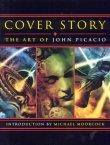John Picacio: Multidimensional
 John Picacio was born September 3, 1969 in San Antonio TX, where he grew up. He attended the University of Texas at Austin, where he studied architecture for five years. He worked as an architect while doing illustration work on the side, beginning with a cover and interiors for the 30th anniversary edition of Michael Moorcock’s Behold the Man. In 2001 he gave up architecture to become a full-time artist, and has produced over 120 cover illustrations, doing work for most of the major genre publishers and many small presses, plus magazine covers and interior artwork.
John Picacio was born September 3, 1969 in San Antonio TX, where he grew up. He attended the University of Texas at Austin, where he studied architecture for five years. He worked as an architect while doing illustration work on the side, beginning with a cover and interiors for the 30th anniversary edition of Michael Moorcock’s Behold the Man. In 2001 he gave up architecture to become a full-time artist, and has produced over 120 cover illustrations, doing work for most of the major genre publishers and many small presses, plus magazine covers and interior artwork.
Some of his artwork was collected in Cover Story: The Art of John Picacio (2006). Recent works include the bestselling 2012 calendar for George R.R. Martin’s A Song of Ice and Fire series, covers for Ian McDonald’s Everness trilogy, and limited editions of the Hyperion Cantos by Dan Simmons.
Picacio’s honors include a World Fantasy Award, a Locus Award, four Chesley Awards, and two International Horror Guild Awards, plus seven Hugo nominations for best professional artist. He lives in San Antonio TX with his wife Traci and their daughter Samantha.
‘‘I don’t regret the five years of architecture school, the long internship hours and years invested, because in the end I became a problem-solver. An architecture degree is really a problem-solving degree, and I’m grateful for that experience. If I’d gotten a traditional art degree, I might have developed my art chops earlier in life, but I wonder if I would have been as quick on my feet – in terms of working with clients, understanding context, and the ability to think outside of the box that you’re not taught in any school.
‘‘Architectural study trains you to hone that kind of mentality into working method. You have to be a multidimensional thinker, if you want to be an architect – not only for the three-dimensional work, but in terms of interpersonal dynamics: how to handle contractors, how to handle clients, how to work with people to make the imaginary real.”
…
In Europe I’d do my work, and then played hooky, going to comic book shops, bookstores, and art museums. I’d always loved superhero comic books (mostly DC and Marvel), but by that point I’d mostly given up on following characters, in favor of following certain creators. The Vertigo line had just started, or was about to start, and there were artists like Dave McKean, Kent Williams, George Pratt…. Neil Gaiman’s Sandman was huge. Those creators were really big on my radar, in terms of comics culture.
 ‘‘The artists that most excited me were the ones who were painting and mixing media, and I felt a release from the traditional feeling that comics has to be a pen and ink medium – it was an explosion of palette. Anything can be used to tell a story, not just the limited set of media that I experienced growing up. Those guys completely opened up the gates for me: I realized you can tell stories in a more multidimensional way.”
‘‘The artists that most excited me were the ones who were painting and mixing media, and I felt a release from the traditional feeling that comics has to be a pen and ink medium – it was an explosion of palette. Anything can be used to tell a story, not just the limited set of media that I experienced growing up. Those guys completely opened up the gates for me: I realized you can tell stories in a more multidimensional way.”
…
‘…at the Montreal Worldcon, [George R.R. Martin] asked if we could have a chat in the bar. He asked if my schedule had room for working on a calendar for A Song of Ice and Fire. My question was, ‘Which month would I be doing?’ His response was, ‘All of them.’
With the calendar work, the challenge was to take a more literal approach but still be a provocative communicator. I took a page from N.C. Wyeth. One of the best things about his art, when he was doing interior illustrations for stories like Treasure Island, was that he would take the beat before or the beat after and illustrate that so his picture wasn’t being redundant of the text. I loved that! So with the calendar, I tried to do things that were (a) not spoilers and (b) resonant in the same way that Wyeth’s illustrations were resonant for me, not just repeating a line of the book. I took great pleasure in finding those moments.”
…
As audience members, we’re all cultural negotiators, and right now there’s a window of time for evolution in publishing because of the big changes brought on by e-books. It’s a game of musical chairs: Everybody’s jockeying for position so they can land on the right one when the music stops. I don’t think we’re doing a very good job of demanding the best from these new technologies. In a lot of ways, we’re constantly trading away culture for the sake of convenience: ‘I can get this super-fast, in a way that I can take it everywhere with me, but am I getting the same quality of experience that I was in a nondigital world?’ (The usual answer so far is ‘No.’)
‘‘If this is such a massive singularity, I expect it to give us more than we had previously. Convenience is not enough. We should be demanding more art, more content, more experience, more personality. The digital movement has the room for creators to bring even more humanity to storytelling, even more art, but I’m not seeing the audience pushing enough for better quality. We’re still merely settling for convenience and cheap prices instead. ‘‘We should be looking to make more art and better experiences with this new technology, and if the audience focuses on that and demands it during this window of opportunity, we might actually get it before the music stops. As a cultural negotiators, we should be saying, ‘I will not be buying this e-book until the format is at least as good as the traditional book. I want the cover to be readable at a nice scale where I can enjoy it, and be able to enlarge and expand it. I want more interiors.’ But we also have to say, ‘I’m willing to pay for that.’ If we just demand the low price or the free grab, we’re going to cut out all the rest of this rich experience that we’re so used to, and if so, we’re lowballing ourselves in this deal. We shouldn’t want less than we had yesterday. By all means, embrace the technology but let’s expect better from it than what we’ve done so far.”


 Excerpts from the interview:
Excerpts from the interview: Read the complete interview, and biographical profile, in the April 2012 issue of Locus Magazine.
Read the complete interview, and biographical profile, in the April 2012 issue of Locus Magazine.



Pingback:SF Tidbits for 4/16/12 - SF Signal – A Speculative Fiction Blog